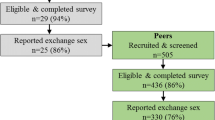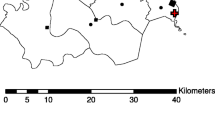Abstract
Few recent publications have highlighted theoretical and methodological challenges using respondent-driven sampling (RDS). To explore why recruitment with RDS may work in some populations and not in others, we assess the implementation of RDS to recruit female sex workers (FSWs) and injection drug users (IDUs) into a human immunodeficiency virus biological and risk behavior survey in Tallinn, Estonia. Recruitment of FSWs was slower and more challenging than that of IDUs. The IDU study recruited 350 participants within 7 weeks, while the FSW study recruited 227 participants over 28 weeks. Implementation modifications that did not negatively impact key RDS theoretical and methodological requirements were used to improve recruitment during the FSW study. We recommend that all RDS studies include a formative research process to involve the participation of target populations and key persons associated with these populations in the study planning and throughout the implementation processes to improve recruitment from the outset and to respond to poor recruitment during data collection.

Similar content being viewed by others
References
Magnani R, Sabin K, Saidel T, Heckathorn DD. Sampling hard to reach and hidden populations for HIV surveillance. AIDS. 2005;19(Suppl 2):S67-S72.
Semaan S, Lauby J, Liebman J. Street and network sampling in evaluation studies of HIV risk-reduction interventions. AIDS Rev. 2002;4:213-223.
Heckathorn DD. Respondent-driven sampling II: deriving valid population estimates from chain-referral samples of hidden populations. Soc Probl. 2002;49:11-34.
Salganik MJ, Heckathorn DD. Sampling and estimation in hidden populations using respondent-driven sampling. Sociol Method. 2004;34:193-239.
Trummal A, Fischer K, Raudne R. HIV-nakkuse levimus ning riskikäitumine prostitutsiooni kaasatud naiste hulgas Tallinnas. National institute for Health Protection, 2006. Accessed on: January 10, 2008. Available at: http://www.tai.ee/failid/PK_HIV_uurimuse_raport_12.2006_1_parandatud.pdf
Uuskula A, Rajaleid K, Talu A, Abel K, Rüütel K, Hay G. Estimating injection drug use prevalence using state wide administrative data sources: Estonia, 2004. Addiction Res Th. 2007;15(4):411-424.
Platt L, Bobrova N, Rhodes T, et al. High HIV prevalence among injecting drug users in Estonia: implications for understanding the risk environment. AIDS. 2006;20(16):2120-2123.
Wilson TE, Sharma A, Zilmer K, Kalikova N, Uusküla A. The HIV prevention needs of injection drug users in Estonia. Int J STD AIDS. 2007;18(6):389-391.
Uusküla A, McNutt LA, Dehovitz J, Fischer K, Heimer R. High prevalence of blood-borne virus infections and high-risk behaviour among injecting drug users in Tallinn, Estonia. Int J STD AIDS. 2007;18(1):41-46.
Uusküla A, Kals M, Rajaleid K, et al. High-prevalence and high-estimated incidence of HIV infection among new injecting drug users in Estonia: need for large-scale prevention programs. J Public Health (Oxf). 2008;30(2):119-125.
Uusküla A, Fischer K, Raudne R, et al. A study on HIV and hepatitis C virus among commercial sex workers in Tallinn. Sex Transm Infect. 2008;84(3):189-191 (a).
Aral SO, St Lawrence JS, Uusküla A. Sex work in Tallinn, Estonia: the sociospatial penetration of sex work into society. Sex Transm Infect. 2006;82(5):348-353.
Heckathorn DD. Extensions of respondent-driven sampling: analyzing continuous variables and controlling for differential degree. Socio Methodol. 2007;37:151-207.
Respondent-driven sampling. Accessed on: October 08, 2007. Available at: http://www.respondentdrivensampling.org.
Heckathorn DD. Respondent-driven sampling: a new approach to the study of hidden populations. Soc Probl. 1997;44:174-199.
Simic M, Johnston LG, Platt L, et al. Exploring barriers to ‘respondent-driven sampling’ in sex worker and drug-injecting sex worker populations in Eastern Europe. J Urban Health. 2006;83(Suppl 6):6-15.
Johnston LG, Malekinejad M, Rifkin MR, Kendall C, Rutherford GW. Implementation challenges to using respondent-driven sampling methodology for HIV biological and behavioral surveillance: field experiences in international settings. AIDS Behav. 2008;12(Suppl 4):S131-S141.
Salganik MJ, Heckathorn DD. Sampling and estimation in hidden populations using respondent-driven sampling. Socio Meth. 2004;34:193-239.
Shakarishvili A, Dubovskaya LK, Zohrabyan LS, et al. LIBRA project investigation team. Sex work, drug use, HIV infection, and spread of sexually transmitted infections in Moscow, Russian Federation. Lancet. 2005;366(9479):57-60.
Des Jarlais DC, Perlis TE, Stimson GV, Poznyak V, WHO Phase II Drug Injection Collaborative Study Group. Using standardized methods for research on HIV and injecting drug use in developing/transitional countries: case study from the WHO Drug Injection Study Phase II. BMC Public Health. 2006;6:54.
Gallo D, George JR, Fitchen JH, Goldstein AS, Hindahl MS. Evaluation of a system using oral mucosal transudate for HIV-1 antibody screening and confirmatory testing. OraSure HIV Clinical Trials Group. JAMA. 1997;277(3):254-258.
Acknowledgment
This research was supported in part through grant R01 DA 03574 from the US National Institute on Drug Abuse, by the Global Fund to Fight AIDS, Tuberculosis, and Malaria who funded this study through the National Institute for Health Development in Estonia (EST-202-G01-H-00), Norwegian Financial Mechanism/EEA (grant EE0016) and by US Civilian Research Development Foundation grant (ESX0-2722-TA-06).
Authors express their gratitude to the teams at the NGOs Me Aitame Sind, Corrigo, and to all participants of the study.
The content of this paper has not been published elsewhere, nor is it being considered elsewhere, nor are there any conflicts of interest contained therein.
Author information
Authors and Affiliations
Corresponding author
Additional information
Contributors
Uusküla, L. Johnston and D. Des Jarlais designed the approach for the comparison analysis. M. Raag performed the needed statistical analyses. A. Uusküla wrote the first draft of the manuscript. All authors contributed to revising the manuscript and have approved the final manuscript.
Rights and permissions
About this article
Cite this article
Uusküla, A., Johnston, L.G., Raag, M. et al. Evaluating Recruitment among Female Sex Workers and Injecting Drug Users at Risk for HIV Using Respondent-driven Sampling in Estonia. J Urban Health 87, 304–317 (2010). https://doi.org/10.1007/s11524-009-9427-7
Received:
Accepted:
Published:
Issue Date:
DOI: https://doi.org/10.1007/s11524-009-9427-7




